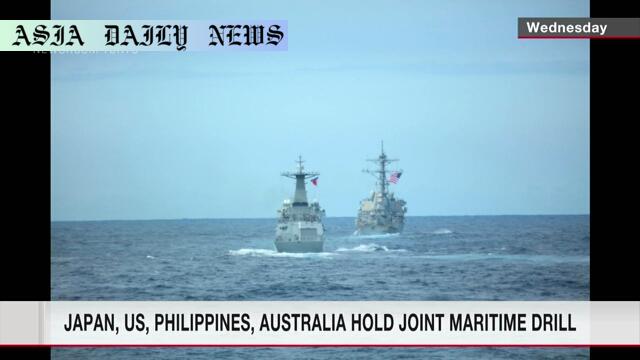Maritime Cooperation – Japan, US, Philippines, and Australia strengthen ties in joint maritime exercises to boost regional security.
Maritime Cooperation in focus as Japan, US, Philippines, and Australia conduct joint naval exercises.
The exercises aim to strengthen military interoperability amid rising tensions in the South China Sea.
Defense leaders from the US and the Philippines discussed reinforcing regional deterrence strategies.

Introduction: Collaborative Naval Efforts
In a significant move towards strengthening maritime security and regional stability, armed forces from Japan, the United States, the Philippines, and Australia conducted a joint naval exercise in the South China Sea. This event marks the first maritime drill involving these four nations since Donald Trump re-assumed office as US president. The exercise, held within the exclusive economic zone of the Philippines, underscores the countries’ collective objective to counter rising tensions and assert their commitment to a secure Indo-Pacific region.
The Objectives of the Maritime Exercise
The joint exercise aimed at enhancing the interoperability of participating navies from the four nations, involving Japan’s Maritime Self-Defense Force, the US and Australian navies, and a Philippine frigate. The collaboration reflects a shared vision of ensuring freedom of navigation, upholding international law, and promoting peace in the region. With China increasing its assertive activities in the South China Sea, this joint maneuver sends a strong message of unity and preparedness.
Strengthening Defense Relationships
This maritime drill is not an isolated event but part of a broader strategic alignment among these nations. On the day of the exercise, US Defense Secretary Pete Hegseth and his Philippine counterpart, Gilberto Teodoro, held a phone conference to discuss enhanced military collaboration. The leaders emphasized rebuilding deterrence and enhancing the capabilities of the Philippine military to address emerging regional threats effectively.
Geopolitical Implications and China’s Expanding Presence
The South China Sea remains a hotspot of geopolitical contention, with China’s continued militarization of artificial islands and expansive territorial claims. For the Philippines, the region has become a focal point of national security, prompting deeper cooperation with allies such as the US, Japan, and Australia. By engaging in collective military exercises, these nations aim to underscore their commitment to preserving regional stability and opposing unilateral actions that undermine international norms.
Militaries Joining Forces for Peace and Deterrence
The participation of destroyers and advanced naval technologies from all four nations underscores the seriousness of their commitment. The exercises included realistic scenarios simulating potential threats in contested waters, enabling the forces to coordinate their responses effectively. Such drills contribute not only to operational readiness but also to building trust among allied nations, ensuring a unified approach in responding to regional challenges.
The Role of Allies in a Tense Regional Environment
For smaller nations like the Philippines, partnerships with larger military powers are crucial. Cooperation with the US, Japan, and Australia enhances Manila’s capability to address both conventional and asymmetric threats. These alliances also reflect a strategic balancing act against China’s growing presence in the region, aiming to deter aggressive moves while maintaining open communication channels to prevent miscalculation or conflict escalation.
Conclusion: A Unified Front for Regional Security
As tensions in the South China Sea continue to escalate, this joint maritime exercise showcases the importance of international alliances in promoting regional security and peace. By working together, Japan, the US, the Philippines, and Australia send a clear message about their commitment to shared values and the rules-based order. Maritime cooperation is not just a demonstration of military strength but a vital mechanism for fostering trust and stability in one of the world’s most critical waterways.



Commentary
Maritime Cooperation as a Testament of Unity
The recent joint maritime exercise by Japan, the US, the Philippines, and Australia highlights a significant and much-needed collaboration in a region known for its geopolitical tensions. These drills symbolize the strong bonds of cooperation and shared commitment to peace and security that exist between these nations. As China continues to assert its influence in the South China Sea, such demonstrations of unity serve as powerful reminders of the collective strength of allied nations.
Geopolitical Stakes in the South China Sea
The South China Sea represents not just a strategic maritime corridor but also a core point of contention in global geopolitics. By conducting such exercises, these nations are not merely preparing for potential confrontations but are also signaling their resolve to uphold international laws and protect their sovereign interests. For the Philippines, these partnerships provide a deterrent against aggressive moves and support for building its nascent defense capabilities.
The Road Ahead for Regional Collaboration
While these exercises demonstrate an impressive unity, long-term success lies in sustained collaboration, trust-building, and dialogue. By fostering stronger defense ties and opening pathways for multilateral engagement, nations in the Indo-Pacific can ensure greater stability. In the face of challenges such as China’s maritime assertiveness, this cooperation serves as a beacon of hope for peaceful coexistence and mutual respect in the region.